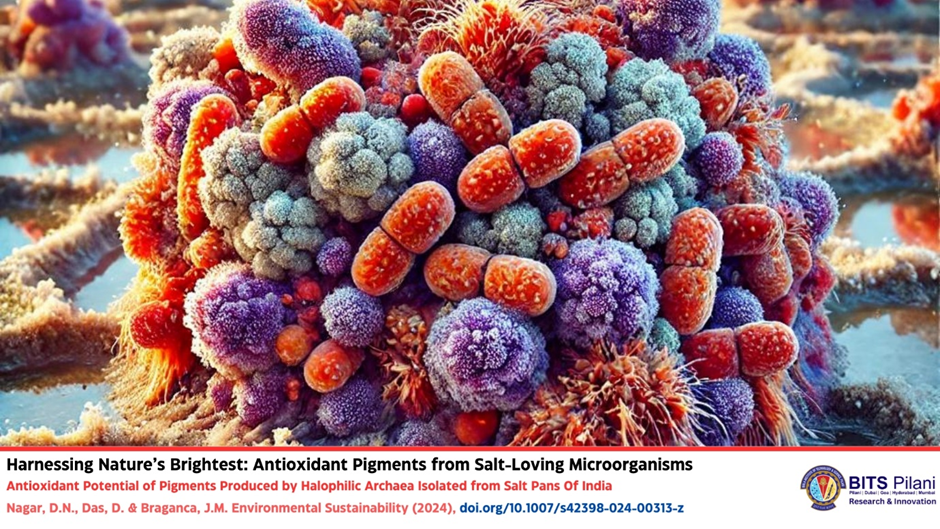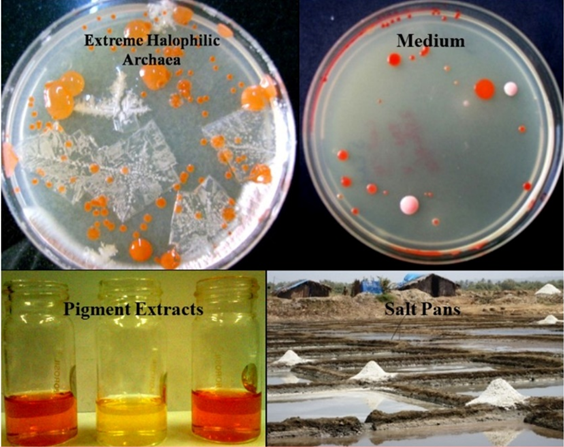Halophilic archaea flourish in environments with high salt concentrations, such as salt pans or solar salterns. Halophiles are known to be able to synthesize and accumulate biomolecules like high ionic strength enzymes, pigments, solutes and more bio-products. The study focused on two specific strains- Halorubrum sp. M5 and Haloarcula sp. E2, that were isolated from salt pans in Tamil Nadu and Goa, India. These microorganisms were chosen for their ability to produce bright orange pigments, hinting at their unique biochemical properties.
Haloarchaea are vibrantly colored due to carotenoids which are pigments that serve multiple roles as accessory pigments aiding in UV radiation protection and as antioxidants. Halophilic pigments are a part of a family of C40 & C50 carotenoids, compounds with long chains of carbon atoms that scavenge free radicals, protecting cells from oxidative damage.
To tap into the potential of these pigments, the researchers grew both Halorubrum sp. M5 and Haloarcula sp. E2 in high-salt media. After 6-10 days, the cultures developed a bright orange color, signaling pigment production. The pigments were extracted through multiple steps and solvents like acetone, methanol, and chloroform were used. Post extraction, the pigments underwent a series of spectroscopic and chromatographic analyses to confirm their identity and antioxidant properties.
A combination of sophisticated techniques such as thin-layer chromatography (TLC), high-performance liquid chromatography (HPLC), Fourier transform infrared spectroscopy (FTIR) and liquid chromatography-mass spectrometry (LCMS) were utilized. Through these techniques the research team identified the pigments primarily as bacterioruberin and its derivatives. The haloarchaeal carotenoids are rich in conjugated double bonds and are responsible for the pigments' ability to neutralize harmful free radicals, making them valuable as natural antioxidants.
The antioxidant potential of these carotenoids was tested using the DPPH assay, a method that measures how well a substance can neutralize free radicals. The results were promising as both pigments demonstrated excellent radical scavenging activity, comparable to Vitamin E which is a well-known antioxidant. This highlights the potential use of these natural compounds as alternatives to synthetic antioxidants in various industries.
To understand the real-world impact of these pigments, the researchers tested the pigment’s protective effects on a human skin cell line, HaCaT keratinocytes. These cells were exposed to oxidative stress induced by hydrogen peroxide, which mimics the kind of damage that skin cells might face from environmental factors like pollution and UV radiation. Remarkably, pre-treating the cells with the pigments boosted their viability, effectively protecting them from oxidative damage. The level of protection was similar to that of Vitamin E, further proving the potency of these natural pigments.
The study’s results are significant, not only in the field of microbiology but also for industries focused on natural and sustainable products. The ability of these pigments to combat oxidative stress opens doors for their use in skincare formulations, particularly in protecting the skin from environmental stressors. Furthermore, biocompatibility with human cells indicates that they can be integrated into skincare products without harmful side effects.
Nature never ceases to amaze us with its hidden treasures, and the discovery of antioxidant pigments from salt-loving archaea is a prime example. This research paves the way for harnessing the power of these natural compounds in cosmetics and skincare, offering a sustainable alternative to synthetic chemicals. As we continue to explore the potential of microorganisms from extreme environments, it becomes clear that nature's solutions often lie in the most unexpected places.
Blog by Navya Debbad


 An Institute of Eminence
An Institute of Eminence









